Let's draw a silhouette
Master Class. We draw the sunset and the silhouette of a tree.
![]()
Glad to everyone who stopped by.
Today we will draw the silhouette of a tree against the background of the setting sun.
It’s not difficult, and the painting looks impressive in the interior.
Children enjoy drawing this landscape.
What do we need?
canvas 20x25 cm 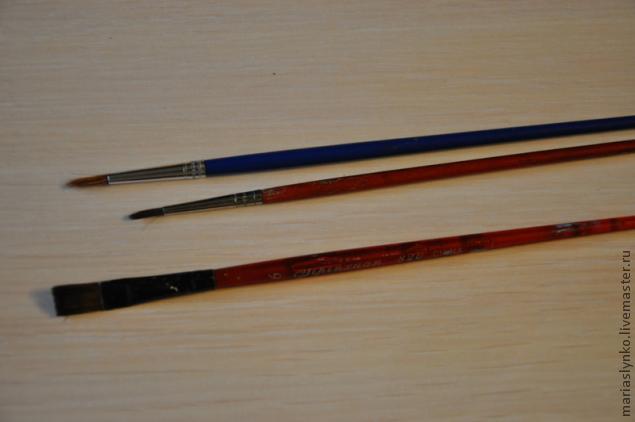
2 brushes (1 wide flat, 1 or 2 thin)
acrylic paints: yellow, red and black
(if there is no acrylic, then you can take gouache and replace the canvas with white cardboard)
foam sponge
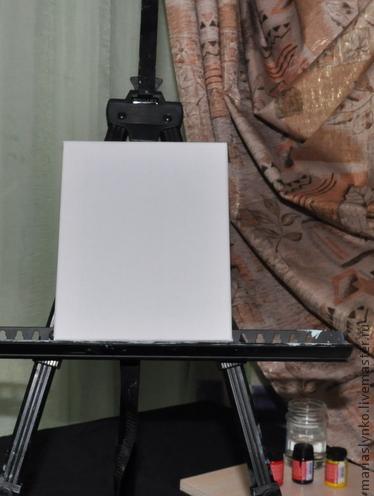
Now let’s go for inspiration to make a pencil sketch of the future tree.
You can look at beautiful photographs of trees on the Internet.
For example, this (in fact, this is the simplest version of the silhouette for the smallest children):

You can go to the park with your children and look at the trunks and branches there to find something suitable.

Now take yellow paint, a thin brush and draw a circle in the center.

On the palette, add a drop of red to yellow, get orange and complete the halo:
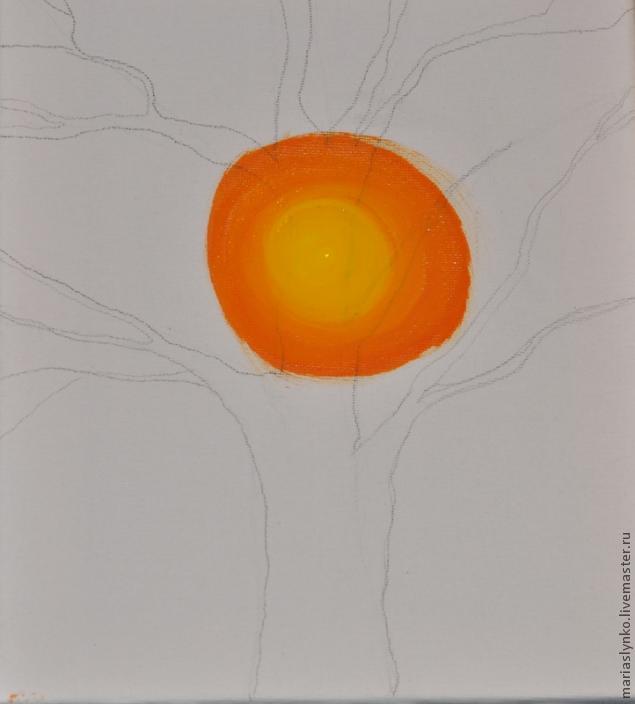
We take a sponge (dry) and carefully model a smooth transition from yellow to orange in a circle; with the other clean end of the sponge we model the transition from orange to red. Fill everything else with red (a wide brush will come in handy here)

We also paint the sides of the canvas.
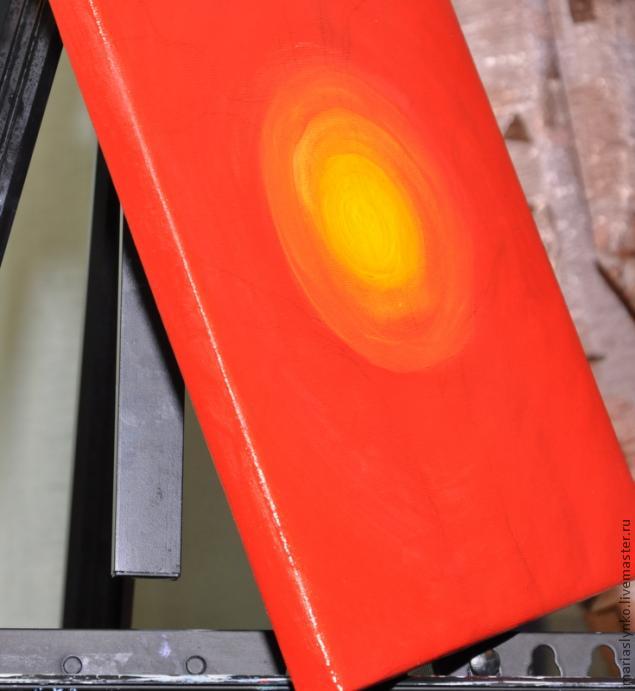
Take a break while the acrylic dries. There is time to drink tea and practice drawing thin branches somewhere on a separate piece of paper. This is the most difficult thing about this landscape.
Hold the brush as in the photo and pull it up, if at the same time it
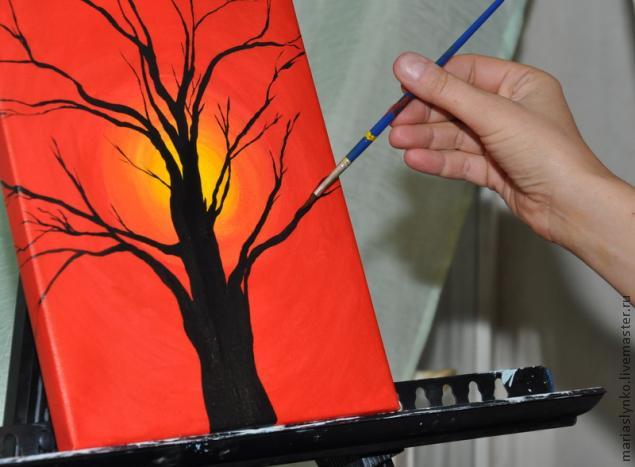
twist it, we get a clumsy, wavy branch.
We take a little paint. (after washing, dry the brush in a sponge, take the paint with a dry brush, otherwise the branch may leak)
We train the degree of pressure: stronger at the base of the branch, pulling it out, gradually reducing the pressure and the branch becomes thinner.
Now our canvas has dried, let's continue.
We take black paint and outline the trunk and main branches.
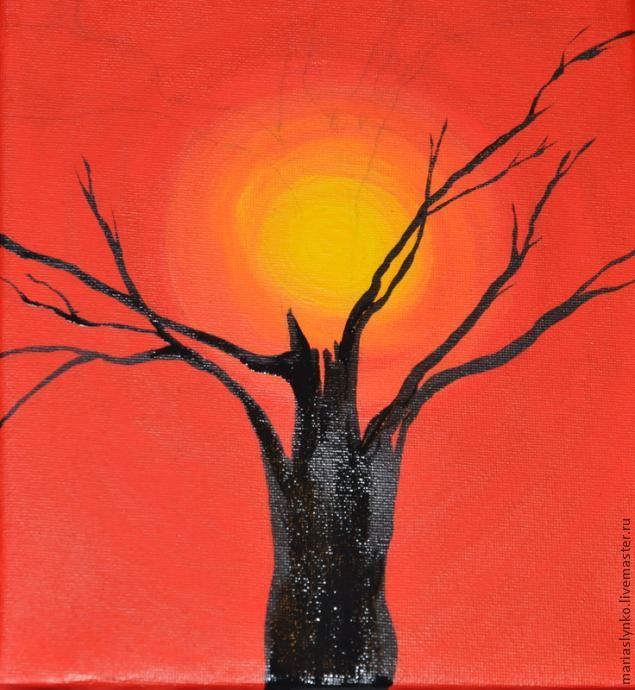
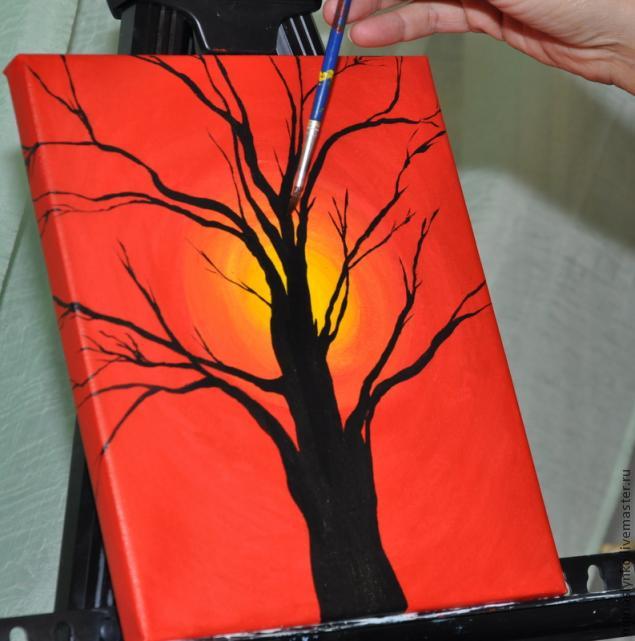
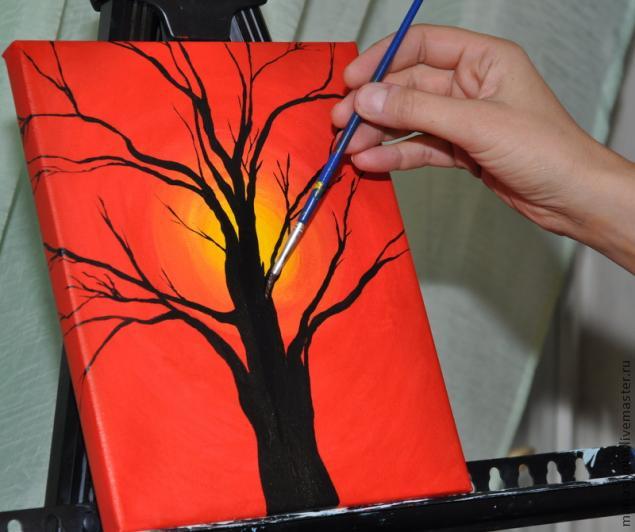
You can continue the flow of branches onto the sidewall, or you can not do this.

That's all. Congratulations!
We made it!
All we have to do is wait until our masterpiece dries and coat it with varnish. I use acrylic-styrene.

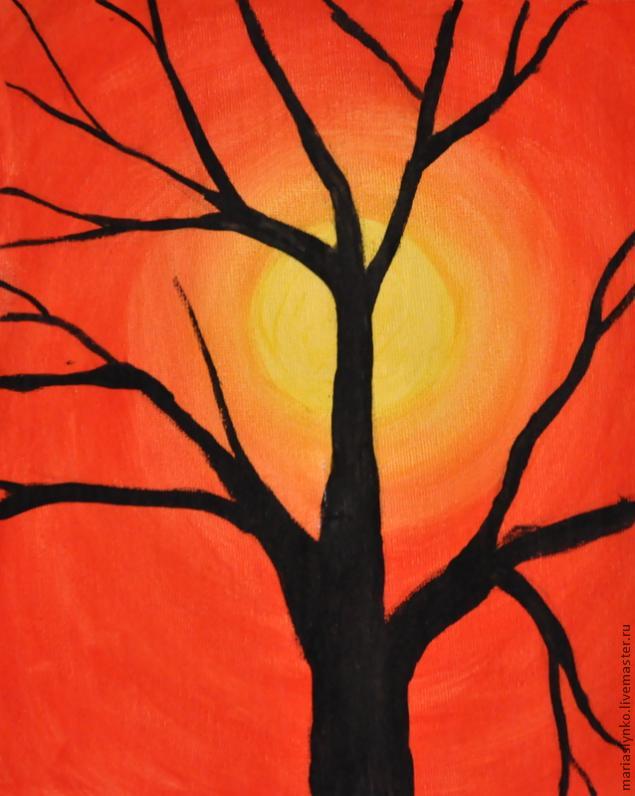
My son drew this landscape.
Well, the very last step is to find a free place for the painting.
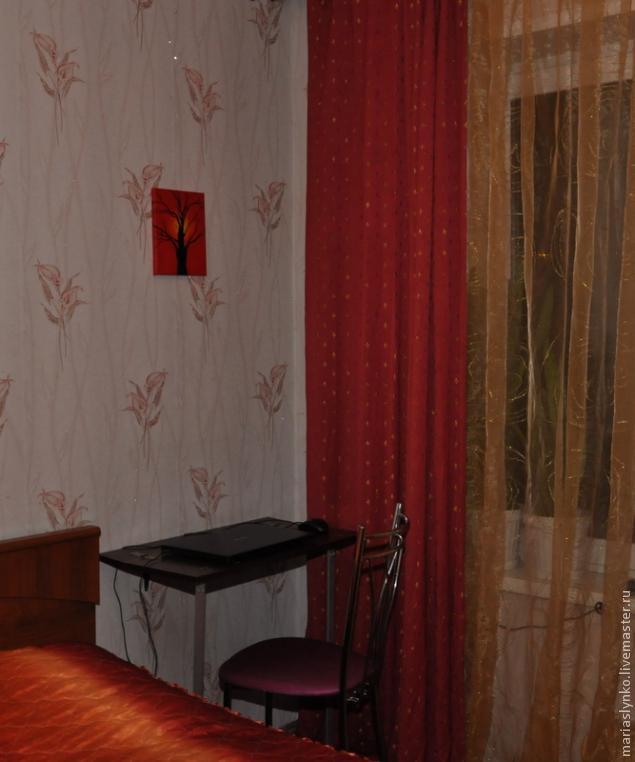
I wish you creative success!
Write about your achievements. It will be interesting. Maybe we’ll also hold a sunset competition :)
Open lesson in fine arts. Topic: “Silhouette” (expressive means of graphics)
Sections: MHC and ISO
Goals:
- introduce students to expressive means of graphics;
- talk about the origin of the word “silhouette”;
- develop creative imagination;
- develop skills in conveying mood in a drawing.
Equipment:
- album sheet, rectangle of black paper 10x14 cm,
- pencil,
- scissors,
- glue,
- eraser,
- tassel,
- rags.
For students:
- line-spot portrait , ,
- silhouettes of N. Ilyina’s work “Pushkin and Nanny”,
- cover by E. Narbut for the book of fables by I.A. Krylov /1 copy on each desk/.
Figure 2
Figure 8
For the teacher:
- silhouette of Krylov,
- black butterfly, white butterfly, colored butterfly, a whole flock of butterflies /silhouette/,
- silhouette illustrations from Krylov’s fables /“The Crow and the Fox”, “The Pig and the Oak”, “The Fox and the Grapes” and others/.
Figure 10
| Figure 11 |
Figure 12
Figure 6
During the classes
1. Org. Moment
2. Main part of the lesson
— Dear guys, Today we will look and talk about not quite ordinary works.
These works are performed by graphic artists . They love black very much, because it is the main color of color and they simply cannot do without it. Everything in them is depicted as black shadows. Such images are called silhouettes .
Silhouette is a type of graphic image. This is a flat, monochromatic image of figures and objects.
- Why do we say that a silhouette is an image in the form of a shadow, which necessarily repeats the object itself ?
- So there are other shadows?
— Indeed, silhouettes can be not only black on a white background, but also white on a black background. (See Fig. 1, 2, 3)
— Consider the following plot of the composition.
The great poet reads poetry to the nanny, and maybe even a fairy tale. She listens to him, sitting at the table, and knits something. The cat probably came to listen too.
— Every object, every figure is a silhouette, but not just in the form of shadows, but shadows that repeat the shape of objects and figures.
— Can you and I see and determine what time of day and even year the action in this composition takes place?
— Outside the window you can see white silhouettes of snow-covered trees, a month and stars on a black background.
- So it’s winter, late evening.
“And it’s unlikely that anyone will recognize this person from his silhouette image.”
- So this is the silhouette of the figure of the great fabulist I.A. Krylov. Big and menacing, wearing a hat and with a cane, he walks through the park.
- What season?
— The silhouettes of intertwined, bare tree branches tell us about autumn.
— Guys, please tell me, looking at these drawings, can you name Krylov’s fables? (See Fig. 5, 6, 7)
Let's see what a wonderful cover E. Narbut made for the book of Krylov's fables.
What is depicted on it in black silhouettes, and what in white? (See Fig. 8)
- Yes , these are shadows falling from objects and figures.
- Remember. You are walking along a street illuminated by lanterns. What's happening to your shadow?
- Why do we find it so funny when we see the shadow of our figure moving away from the lantern?
- Right. The shadows lengthen and narrow.
“She has nothing in common with our figure.”
- This means that for silhouette images we need only those shadows that convey the utmost resemblance to a person or object.
Let us note one more feature of the silhouette.
— A black butterfly flew onto a white field. (See Figure 9)
— A white butterfly and landed on a black field . (See Fig. 10)
— The third butterfly - a multi-colored one . (See Fig. 11)
— How do its wings differ from the wings of silhouette butterflies, except for color?
— A colored butterfly’s wings are detailed inside—there are veins, dots, and specks. The silhouette inside is not worked out.
“That’s why it’s perceived as a stain.”
- Here is a whole flock of butterflies . (See Fig. 12 )
From a distance they look like black specks.
- But these are not just blots. Each butterfly has its own wing shape.
And therefore we can distinguish silhouettes from each other.
— I wonder why the images in the form of shadows were called “Silhouette” and not otherwise?
-Where did this word come from?
His name was Eugene de Silhouette. He was the Marquis and Minister of Finance of France, that is, he was in charge of the money of the entire country: where and what to spend it on. Silhouette was noble and rich, but few people loved him. And then one day early in the morning a newspaper came out with his portrait. The artist depicted his head in profile in the form of a shadow.
The minister already had a long nose, but the artist decided to joke and drew it even longer. But the people who bought the newspapers still recognized him as their finance minister and laughed merrily, pointing their fingers at the newspaper. Silhouette images began to come into fashion. It was very expensive to order a portrait from a painter, but many people wanted to have their own portrait for a lower price. Such portraits were used to decorate the walls of rooms, offices, boxes, and jewelry.
Such images came to be called “silhouettes” . This was almost 200 years ago.
— Tell me, please, why do you think people’s heads are depicted in profile and not from the front?
- Because with this position of the head we have a better idea of the person’s facial features in silhouette.
— And today we will try to imagine and create the silhouette of our favorite fairy-tale hero.
— Please name your favorite fairy-tale characters.
1. On the back of the black rectangle, draw a large picture of a fairy-tale hero in profile.
2. You need to cut along the contour, starting from the side.
3. Beautifully arrange both elements obtained from a black rectangle on the sheet.
4. Stick them on. Then you get a white silhouette on a black background and a black silhouette on a white background. Write the title of the lesson.
Result: The most expressive silhouettes are noted. Exhibition of works.
1. What silhouettes are there? /Black, white/.
2.Where did the word Silhouette come from? /From the name of the Minister of Finance Eugene de Silhouette/
Plus Photoshop.ru
This is an average difficulty lesson. It can be difficult for adults to repeat this lesson, so I don’t recommend drawing a silhouette using this lesson for young children, but if you really want to, you can try. I also want to note the lesson “How to draw a toy” - be sure to try it again if you have time and desire to draw today.
What you will need
In order to draw a silhouette we may need:
- Graphic editor GIMP. You need to download the new GIMP for Win or Mac OS and install it.
- Download brushes for GIMP, they may come in handy.
- Some add-ons may be needed (instructions on how to install them).
- A little patience.
- Good mood.
Step by step lesson
All people are united by many anatomical properties: two arms, two legs, one head, etc. But every person is unique. Some have more developed muscles, some have deeper-set eyes, and some wear a creative hairstyle. To draw a silhouette as correctly as possible, you need nature. Well, or many different photographs that you can study.
By the way, in addition to this lesson, I advise you to pay attention to the lesson “Drawing a leopard”. It will help improve your skill or just give you a little fun.
Tip: Perform different actions on different layers. The more layers you make, the easier it will be for you to manage the drawing. So the sketch can be made on the bottom layer, and the white version on the top, and when the sketch is not needed, you can simply turn off the visibility of this layer.
As you complete this tutorial, please note that due to differences in software versions, some menu items and tools may have different names or be missing altogether. This may make the tutorial a little difficult, but I think you can do it.
I decided to write it because I myself spent a very long time looking for silhouettes and how to make them. As a result, I did not find a single lesson for GIMP on creating silhouettes. I wrote it myself and am ready to accept your criticism.
Open the image from which you want to get a silhouette. I took an image I found on the Internet. I think the person in the image will not be offended.

Now we need to select the person. To fill the selection, use a gradient: foreground color black, background color 504c4a. Gradient shape Bilinear. Invert the selection (right mouse button>selection>invert). Fill everything that we don’t need with white. It turns out like this:

We do not close this image; we will need it in the future; we will continue to work with its copy. Let's call it "Source"
Create a copy of the layer. For now, turn off the original image (remove the eye in front of the image in the “Layers, Channels, Paths” Window).
Select Our Silhouette again and invert the selection. Then you need to deal with the background for the background I chose these colors: foreground color 96ebec, background color black. The gradient shape is radial. Draw a gradient from the middle of the picture up. You should end up with something similar to this:

Let's call this layer "Original".
Now you need to add an eye opposite the original image. We again select the silhouette of a person, this is done easily using the magic wand on the toolbar. Create a new layer (layer fill type TRANSPARENT). Copy the selected silhouette to a new layer. On a new layer we change the color of the silhouette to white. In the end it should look like this:

Place the “Source” layer above the “Original” layer. We do this in the panel on the right (panel with layers). Now we work with the “Source” layer. Set its opacity to 3.5−4%. The opacity is set in the same panel on the right. You will have to play with it a little to achieve the desired effect. Now move the selected silhouette a little down and to the left. If we want to add some movement, then select the contour tool on the toolbar and outline the areas we need, then click select from contour and set these settings

Moreover, the brush settings should be something like this:

If everything is done correctly, it turns out like this:

Now all that remains is to make the colors brighter and decorate the silhouette a little (this depends on your imagination, you can use inscriptions). In my example, I took a brush from the standard set. It turned out like this for me:

How can you make colors stand out more? It's very simple: after we've finished our work and brought all the layers together, we make a copy of the resulting image and set the mode to "Overlay" and the layer opacity to about 40%. We bring the layers together and you're done.
Now you know how to draw a silhouette. If you put in the effort, I believe you will achieve everything you set your mind to. Now you can pay attention to the lesson “How to draw a turtle” - it is just as interesting and exciting. Share this lesson with your friends on social media. networks.
Art lesson in 6th grade. “Silhouette as an expressive means of graphics” (according to the program “Fine Arts and Artistic Work” by B. M. Nemensky)
Document selected for viewing silhouette.ppt

Description of the presentation by individual slides:
In the enjoyment of beauty there is an element of pleasure in thinking /Aristotle/
Etienne de Silhouette (1709—1767)
The document selected for viewing is the lesson Silhouette.docx





































































 Methodological development of a fine arts lesson in 6th grade on the topic: “SLUET AS AN EXPRESSIVE MEANS OF GRAPHICS.”
Methodological development of a fine arts lesson in 6th grade on the topic: “SLUET AS AN EXPRESSIVE MEANS OF GRAPHICS.”
A summary of an integrated fine arts lesson for 6th grade students is presented. The topic of the lesson is “Silhouette as an expressive means of graphics” (according to the program “Fine Arts and Artistic Work” by B.M. Nemensky)
Objective of the lesson: Image of a human figure. The main task is to develop a “feeling” of silhouette and large forms, on which the expressiveness of both the overall composition and the depicted characters and objects depends.
Mastering the silhouette of the image is achieved by means of appliqué from black paper by cutting and sticking on a white background. A clean silhouette is used here. give an idea of the silhouette as a type of visual activity - graphics.
Educational : develop an understanding of the origins of the artist’s creativity; teach silhouette techniques;
Introduce children to creating an image of a person in art using the concept of “silhouette”.
promote the development of artistic imagination, desire and interest in creativity;
Forming the skill of creating an expressive silhouette using black paper.
develop a sense of self-confidence to support creative success.
For the teacher: multimedia board , multimedia presentation “Silhouette”, video “sand drawings”, CD with music for relaxation.
For students: black cardboard, scissors, glue stick
How to draw a female figure
Good afternoon, today we will teach you how to draw a female figure, on the one hand it is difficult, but on the other hand it is very interesting and exciting. The instructions and detailed description we provide below will help teach you how to draw a female figure quickly using various graphic effects.
The female figure, like any figure of another representative of the human or animal world, is individual. And consists of different parts: head, body, arms and legs. And all these body parts can belong to a young or old woman, and she can also be slim, tall, short or plump. Therefore, if you end up with a girl’s figure that is not the same as ours, it’s okay - all people are individual.
Step 1
How to draw a woman's face. Before us is a woman's face. The female form has very soft and smooth lines. At the beginning, an oval of the face is drawn, its base (red line). Then eyes, nose, hair, eyebrows are added to the female appearance.

Sequence of drawing a woman's face
Again, hair can be long or short, eyes large or slanted. It all depends on your imagination and creative skills. Now some examples of how to draw a hairstyle. As you can see, women's hair also has a soft shape.

Options for drawing women's hairstyles
Step 2
Options for depicting women at different ages:

Female face options
1. child
2. teenager
3. middle-aged woman
4. elderly woman
We think that this example will help you in the future when working independently on drawing female figures and individual body parts.
Step 3
Image of female eyes. In the image of a woman, eyes are very important. They can be innocent (2), cunning (3), feminine (4) or naive, it depends on the image you paint.

Options for depicting female eyes
Step 4
How to draw a female figure . Like the face and hair, a woman's body also has soft lines.

Here are a few examples of characters, their bodies in motion. A girl who jumps, sits, stretches, stands. There are a million options. It all depends on your imagination and the character you are drawing.

How to draw a female figure
Step 5
Next are the types of female body. Usually women are drawn with approximately the same proportions, here we have indicated different types. Some people have hips that are wider than their chests, while others have the opposite. It depends on genetics.

Different female body types
Step 6
Perspective, view from different angles. Below, above, in front. It is very important to know how to correctly depict a woman’s figure in perspective.

Perspective. View of a female figure from an angle.
How to draw a female figure, example:
Taking everything described above as a basis, we will draw a figure of a girl from the back step by step.
Our girl is young, slightly thin, she stands with her back to us and, turning slightly, looks around. Our girl is barefoot and has long brown hair. She is wearing a light summer dress with an open back. You can, based on our example, draw any other girl, older, of a different shape and dressed in different clothes. It all depends on the play of your imagination. Let's get started.
Aqua city. Available Italian plumbing and bathroom furniture in Tula. Choose!

Example of how to draw a female figure
First, we draw the basis, the skeleton of our drawing. These are the lines from which we will build when drawing our girl. The lines marked in red are exactly the lines that need to be drawn at this step, we did this for convenience. You don't have to paint them red.

The basis of the female figure
Now let’s draw the shape of the face, her snub nose is slightly turned up, it doesn’t matter if you get a nose of a different shape.

Next are the eyes and eyebrows. As you can see, the girl is looking away.

Drawing eyes and eyebrows
Now we draw the mouth, nose and adjust the eyes. The whole drawing will depend on how you draw the face, whether it will be a smiling girl or a thoughtful one, maybe she is saying something. In our drawing, the girl’s face does not express any emotions, which gives her image a certain mystery.

Drawing the mouth and nose
Let's draw her beautiful long hair.

Now let's draw the strands of hair. The hair is long and hangs from the shoulders to the girl's chest. At your request, hair can be of any length and color.

Drawing strands of hair
Let's draw hands. Since the hands are clenched, there is no need to draw them separately.

Let's draw the fingers and a few lines of the back and elbows.

Drawing fingers
We draw the outline of the skirt, or rather the hem of the dress, it is light, summery, the hem of the dress is lifted by the breeze, which gives our figure lightness and mystery.

Draw the outline of the skirt
Then we add pleats to the skirt. This will give our heroine a more realistic look.

Draw folds on the skirt
Drawing women's legs. Now let's draw the outlines of the legs. The lines of the legs that need to be drawn are drawn in red. Our girl is standing barefoot, but if you wish, you can put her on shoes or any other footwear. You can experiment on your own.

Drawing the contours of the legs
Let's add a few strokes to the legs and erase unnecessary lines.


Removing unnecessary lines
Now, the only thing we need is to add color to our image. Good job guys!
Drawing Silhouette
drawing 1986
Sometimes you see everything on the same plane.
The Kidnapper (Karla and Granny in the Sky) https://www.proz
Poems for the drawing Scenes from knightly times https://www.proza.ru/2009/10/09/1094
Drawing In a communal apartment (According to Zoshchenko) https://www.proza.ru/2009/10/10/881
Drawing of an Old Lady from English fairy tales https://www.proza.ru/2009/10/11/441
Drawing Self-portrait at work (Janitor in the Writers' Union) https://www.proza.ru/2009/10/24/929
Yesenin's beloved house on Nikitskaya https://www.proza.ru/2010/03/17/738
Drawing Wet (skeletons under the coffin lid) https://www.proza.ru/2009/11/16/171
Mystical drawings from life Fedorov-Mystic
Sergey Fedorov-Mystic
Drawing “Father Vsevolod Shpiller on the eve of his funeral service” https://www.proza.ru/2009/12/25/1601
Drawing “Invocation” Appearance of Father Vsevolod at the Liturgy of Basil the Great, a week after his death https://www.proza.ru/2010/01/30/62
Drawing “The phenomenon of prt. Vsevolod Shpiller to Patriarch Pimen February 7, 1984 Nikolo-Kuznetsky Temple. Feast of the Icon of the Mother of God “Quiet My Sorrows” https://www.proza.ru/2009/05/25/733
Drawing “Conversation with Father Vsevolod on the day of his remembrance” https://www.proza.ru/2010/12/26/64
Drawing “Father Vsevolod at the Feast of the Icon of the Mother of God Recovering the Dead 1984 (40 days have not yet passed)" https://www.proza.ru/2010/03/01/138
Drawing “Most Pure. Nikolo-Kuznetsk Church February 6, 1985." https://www.proza.ru/2010/01/23/34
Drawing Sketch. “Appearance of the Most Pure One in Kuznetsy on February 6, 1985.” https://www.proza.ru/2009/12/26/31
Drawing “O. Vsevolod at the All-Night Vigil in the Church on Preobrazhenskaya https://www.proza.ru/2009/12/26/56
Drawing “O. Vsevolod in the kitchen of his apartment. (after death)" https://www.proza.ru/2009/12/26/75
Drawing "O. Vsevolod is in the hallway. After death." https://www.proza.ru/2011/01/18/1712
Drawing “Agrippina Nikolaevna and Father Vsevolod at the door of the temple. Blacksmiths" https://www.proza.ru/2011/01/07/264
Drawing “Archm. John the Peasant's entrance into metaphysics" Pechora of Pskov https://www.proza.ru/2010/01/06/1448
Drawing “O. John Krestyankin among us in the apartment (metaphysically)” https://www.proza.ru/2010/12/27/81
Sketch “Archm. John the Peasant after his death" St. Michael's Church. https://www.proza.ru/2010/01/01/169
Drawing “Angelic forces and Father John in spiritual heaven” https://www.proza.ru/2011/02/06/141
Drawing “Metropolitan Anthony Blum. Exit to metaphysics" https://www.proza.ru/2010/01/22/1649
Drawing “Archimandrite Abel Makedonov overhead in the train” https://www.proza.ru/2010/01/06/1198
Drawing “Patriarch Alexy II, exit into metaphysics” https://www.proza.ru/2010/01/23/53
Drawing “The confessor contemplates his child through the wall of his office” https://www.proza.ru/2010/01/23/490
Drawing “Archimandrite Kirill Pavlov in Confession” https://www.proza.ru/2010/03/01/1016
Sketch “The Elder. Entering metaphysics at the liturgy" https://www.proza.ru/2009/12/12/626
Drawing “The Elder in Metaphysics at the All-Night Vigil on the Feast of the Transfiguration” https://www.proza.ru/2011/01/15/159
Drawing “The entry of a family elder into metaphysics” https://www.proza.ru/2011/01/18/72
Drawing “St. Savva Storozhevsky apparition in the Church of the Assumption on Gorodok. Zvenigorod 1985" https://www.proza.ru/2010/01/30/55
Drawing “The first appearance of the scheme. Seraphim of the Kochetkova Eldress of the Spaso-Blachernae Monastery" https://www.proza.ru/2010/01/23/84
Sketch “Appearance of Scheme Seraphima Kochetkova, the clergy house at the Church of the Ascension in Peremilovo” https://www.proza.ru/2009/12/19/171
Sketch “O. Alexander Men at his funeral service in Novaya Derevnya” https://www.proza.ru/2010/01/01/751
Drawing “Psalter for Princess Peresvetova” https://www.proza.ru/2010/01/06/1319
Drawing “Igor Borisovich Pomerantsev at his funeral service. Temple of Elijah the Ordinary" https://www.proza.ru/2010/01/23/106
Drawing “Appearance of Igor Borisovich Pomerantsev at the dacha. (Zagorsk)" https://www.proza.ru/2010/02/20/1330
Drawing “Death of Panteleimon Ivanovich Vasiliev” https://www.proza.ru/2010/01/26/113
Drawing “Gorky in his house-museum on Nikitskaya” https://www.proza.ru/2011/01/01/802
Drawing “The Dark Spirit of the Arbat Apartment” Illustration for the “Arbat Old Woman” https://www.proza.ru/2011/01/29/1661
Drawing “Meetings of friends in the apartment of an obsessed person” https://www.proza.ru/2011/01/30/121
Drawing "On the bus." Illustration for “The Old Lady of Arbat” https://www.proza.ru/2010/01/23/546
Drawing “Natalia’s smile at her funeral service” https://www.proza.ru/2011/01/17/148
Drawing “Funeral service of Leonid K. Temple of Ilya the Obydenny 2008.” https://www.proza.ru/2011/01/29/543
An album of mystical drawings by the author from life under the general title “Little Lisa’s Angel” (based on the first drawing) on the forum of Deacon Kuraev
Oh, silhouette!
In this issue, pedagogical advice is given by Larisa Anatolyevna Franchuk, teacher at Children's Art School, Rybinsk, Yaroslavl region
Making silhouette drawings is a favorite activity in many art schools. And ours is no exception. But we improved this task, combining silhouette and spatiality in one picture. I invite my colleagues to get acquainted with our achievements.
We teach several lessons on the topic “Silhouette”.
1 lesson .
Introduction to the classical concept of silhouette as one of the most expressive techniques of graphics, a story about the history of the appearance of the silhouette, about famous masters of silhouette drawing. On the role of silhouette in composition. For clarity, we use frames with stretched tracing paper, on which we demonstrate the appearance of the silhouette of various objects using powerful lighting (shadow theater).
Practical task: we draw silhouettes of dishes, furniture, figures of people and animals, buildings and trees, clouds and everything that surrounds us from memory and from life!
Homework - draw a silhouette of an indoor flower. We draw the children's attention to the fact that the silhouette of a flower is not just an outline of a plant, but a creative processing by an artist of elements of nature, turning them into a work of art, a small masterpiece! Therefore, each twig, leaf or bud must find its most beautiful, the only possible location in the overall composition of the picture.
Lesson 2. It begins with sketches of classmates using silhouette techniques. The guys draw each other, noticing the individual features of the figure, looking for the most expressive angles and turns, trying to include elements of furniture and surrounding objects in the sketch.
Next, using the material collected in the previous lesson, a sketch of a future composition on the theme “Me and the modern world” is created. (The choice of topic varies depending on the preferences of the teacher, age and preparedness of the children). This is one of the most difficult and responsible lessons in the entire series. Here it is necessary to take into account not only the harmony of the silhouette, but also its further division into plans of the first, second and third levels in accordance with the distance of objects! Here the guys are talking about aerial perspective, about the use of tonal stretching (tonal scale) to convey the illusion of space.
As an example, works from previous years are shown.
Homework is to make as many variants of compositions on a given topic as possible.
Lesson 3 . Discussion and approval of sketches. Execution of the composition on the final version.
Practical work: drawing an approved sketch on the appropriate paper format and transferring different plans of the composition onto tracing paper (3-4 plans).
Next comes the execution of silhouettes. We start working from the farthest, then select the tone for the second and third plans and write them. The closest, darkest silhouette is executed last. We work with ink and gouache. Homework is to complete the work.
Lesson 4 Review and discussion of works, analysis, revision and summing up.

